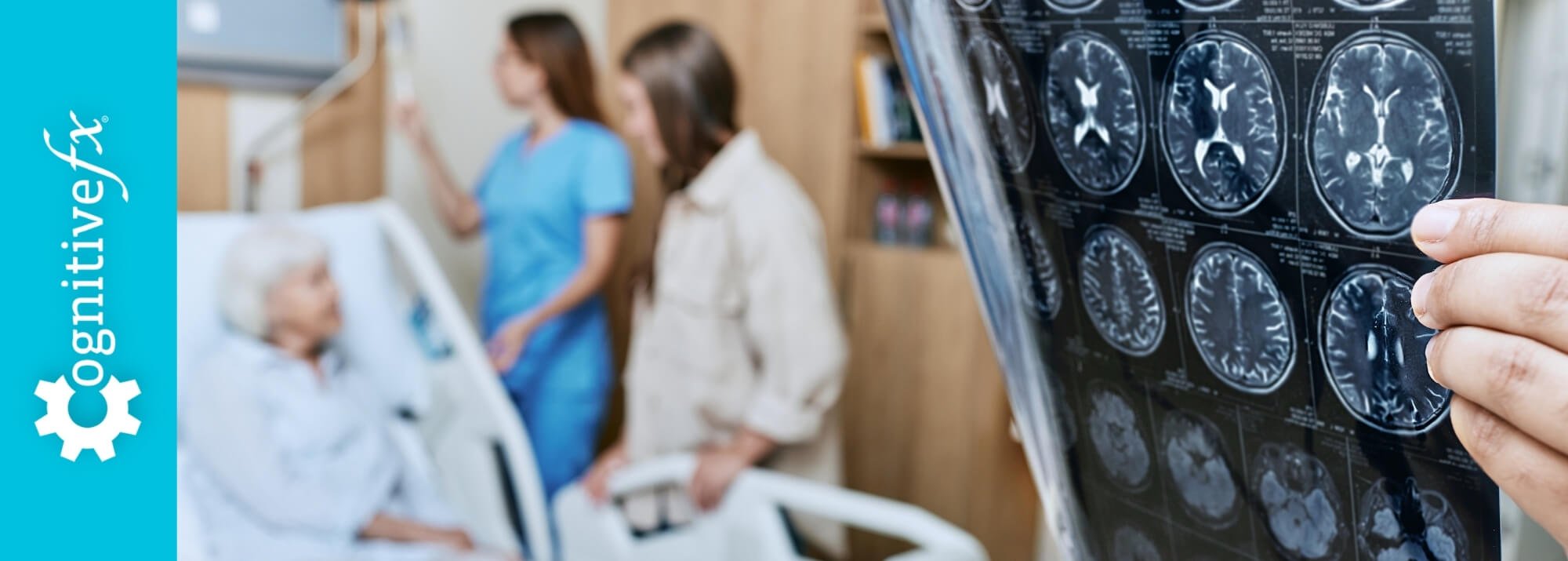If you or one of your loved ones have experienced a minor stroke, known as a transient ischemic attack (TIA) or mini-stroke, you may want to find supportive therapy options to address acute symptoms, reduce the risk of a recurrent stroke, or treat the long-term effects that have persisted after an attack.
Unfortunately, for many people in this position, this can prove to be more challenging than you would expect. Most resources that discuss treatment options for TIAs include lifestyle changes, medications, and surgical care, but rarely include information on how to obtain supportive therapy.
And yet, particularly for patients who have been experiencing difficult long-term symptoms after a TIA — such as issues with memory, executive function, personality change, and other cognitive difficulties — getting the right therapy can be transformative for recovery and improving quality of life.
So, in this article we’re going to discuss:
If you’ve been suffering from lingering symptoms after a TIA, you’re not alone and you’re not crazy. TIA can and does cause persistent symptoms that won’t resolve without treatment. 90% of our patients experience significant symptom improvement after treatment at our clinic. Book a consultation with our team to learn if we can help you.
What Are Your Options for Supportive Therapy After a Mini-Stroke?

In this section, we’ll discuss the therapeutic and supportive options that are available to patients who have suffered TIAs, broken down into two categories:
- Supportive therapy for treating the acute symptoms and causes of a TIA
- Supportive therapy for treating the persistent after-effects of a TIA
We separate these because, as we’ll explain below, support for treating persistent symptoms is markedly different from treating acute symptoms and causes.
1. Supportive Therapy for Treating Acute Symptoms and Causes of TIAs
Depending on their symptoms, some patients may receive brief physical, occupational, or speech therapy at the hospital or shortly thereafter. However, this therapy tends to be short-term, and some patients may need continued support in treating their stroke symptoms, which can include:
- Balance problems
- Visual difficulties
- Facial weakness
- Arm and limb weakness or numbness
- Mildly slurred speech
To help treat these symptoms or reduce the risk of future mini-strokes, patients might consider the following therapies or services based on their needs:
- Physical therapy: If a patient has persistent issues with balance, walking, or movement after experiencing a TIA, working with a physical therapist can help to improve these symptoms.
- Occupational therapy: If a patient has had difficulty resuming activities in their daily life, working with an occupational therapist can help them regain their independence and functioning in meaningful areas.
- Speech therapy: If speech issues have persisted after a TIA, working with a speech therapist can help address and improve them.
- Vision therapy: If eyesight issues have persisted after a TIA, vision therapy can help to correct or improve them.
- Pharmacologic therapy: If necessary and prescribed, medications (such as statins) can be used to address specific causes or symptoms of a patient's TIA.
- Dietitian services: If obesity, high blood pressure, cholesterol levels, or other diet-related issues have been identified, a dietician can help design a diet that meets the patient’s needs and tastes, as well as provide accountability for sticking with a dietary plan.
- Physical training services: Increasing physical activity is often recommended to reduce the risk of stroke and support cardiovascular health. If this is an area that a patient wants support in, a certified physical trainer may be able to design an exercise routine and provide accountability for maintaining the habit.
In the best-case scenario, some combination of these supportive therapies will help patients who’ve suffered a TIA heal and return to normal activity. However, it’s not unusual for some of the symptoms mentioned above to persist, often accompanied by cognitive and emotional challenges, such as memory problems, emotional difficulties, trouble concentrating, brain fog, and more.
While these symptoms may resolve with time, if they’re still present three months after your TIA, they probably won’t go away on their own. Appropriate therapy can help them resolve, which brings us to supportive therapy for the long-term effects of TIAs.
2. Supportive Therapy for Long-Term After-Effects of TIAs
In a previous post, we explained how and why TIAs can cause persistent after-effects. In short, during a transient ischemic attack, a blood clot restricts or prevents blood from reaching certain subsections of the brain. These parts of the brain may experience a deficit of needed resources, such as sugar and oxygen, for minutes to hours. After the TIA resolves, the brain doesn’t fully return to normal. Clinical studies using functional MRI (fMRI) show that even the resting state MRI of TIA patients is abnormal. (This means that their brains don’t look like normal healthy brains do, even while resting from tasks).
Those minutes to hours of restricted blood flow during a TIA can be enough to cause neurovascular coupling dysfunction, in which the relationship between your neurons and the blood vessels that supply them has changed or is not working very well.
When that relationship is disrupted, an area of the brain may start a task and fail to complete it due to a lack of resources. Or, it might call for more blood supply than it should, depriving another part of the brain of what it needs. On imaging, we see this dysfunction as hyperactive (doing too much or taking too many resources) or hypoactive (doing too little) regions of the brain.
That signaling dysfunction is behind many of the lingering symptoms after a TIA.
Furthermore, TIA often occurs deep in the center of the brain. The carotid arteries bring blood to the brain, with smaller and smaller blood vessels traveling to specific subsections, like tree branches.
.png?width=1200&height=881&name=TIA%20(1).png)
After the blockage breaks up, pieces of the clot may travel down the smaller blood vessels (capillaries) until they become lodged in place again. As a result, you may have a cluster of brain cells that die when they no longer receive fresh oxygen.
.png?width=1280&height=780&name=TIA%20(2).png)
In this figure, we see a patient before (A) and after (B) a TIA caused a small cluster of dead brain cells. [Source]
Dead brain cells show up as little white dots on magnetic resonance imaging (MRI) of the brain, as shown above. A neuroradiologist (a highly trained healthcare specialist who works closely with neurologists and neurosurgeons) might see that spot and note it as “nonspecific findings” because that tiny cluster of dead cells won’t kill you. But remember, those cells were doing something before your TIA. And now, some other part of the brain has to compensate for the cells that are no longer viable.
Recovering from that damage requires teaching the brain to route communication around the damaged areas and restoring healthy neurovascular coupling. This is what we help patients achieve at our clinic, where we treat lingering physical and cognitive symptoms from brain injuries, including TIAs.
How We Treat the Long-Term Symptoms of TIAs at Cognitive FX
Before treatment starts at Cognitive FX, our team assesses each patient’s medical history, symptom profile, and physical, cognitive, and psychological well-being.
This includes:
- Physical performance, including reflex response, balance, hand-eye coordination, and so forth.
- Cognitive abilities, such as memory, thinking, executive function, and problem-solving skills.
- Emotional status, including signs of anxiety, depression, or other mental health conditions.
Patients also go through a unique and powerful brain imaging scan, called functional NeuroCognitive Imaging (fNCI), to determine how and where the TIA affected their brain function. This scan assesses about 100 different areas in the brain and how those regions communicate with each other while the patient carries out a series of standardized cognitive tasks.
.jpg?width=689&height=470&name=TIA%20(3).jpg)
fNCI results from a patient with healthy neurovascular coupling. Scores in the yellow and red zones often indicate poor NVC.
Combining all of this information allows our multidisciplinary team (made up of experts in neuroscience, neuropsychology, physical and occupational therapy, psychotherapy, and more) to design a customized treatment plan to target the areas in the brain that were most affected by the TIA.
These are the two characteristics of Cognitive FX that set our clinic apart from other therapy options and allow us to consistently help our patients see significant improvements in their symptoms. The fNCI scan gives us detailed insight into the patient’s brain health to customize treatment. For example, if we see from the fNCI scan that sustained attention is poor, then our therapists can work on more exercises to improve that specific function during treatment week.
Second, instead of being treated by doctors and therapists from different offices who don’t communicate or coordinate with one another (with appointments spread out over weeks or months at a time), our multidisciplinary team works closely together so that every aspect of treatment is tightly coordinated. We even have a Slack channel where we share notes throughout the day on how each patient is responding to therapy, what needs to change in an upcoming session, and anything the next therapist should consider.
During treatment week, patients go through an evidence-based, three-step cycle that is repeated several times a day: Prepare, Activate, and Recover. The goal is to restore normal neurovascular coupling, recover normal function of the autonomic nervous system, and reduce the incidence and severity of long-term symptoms from the TIA.
.jpg?width=1600&height=1067&name=TIA%20(4).jpg)
Prepare
Typically, sessions start with a period of aerobic exercise intervals (usually on a treadmill or stationary bike) to take advantage of a phenomenon in the brain called post-exercise cognitive boost (PECB). PECB triggers the release of chemicals in the brain, including a compound called brain-derived neurotrophic factor (BDNF). BDNF promotes the growth of brain cells and improves communication between different areas of the brain. In turn, this helps the patient's brain become more flexible and boosts the effect of subsequent therapy.
Patients who struggle with physical activity still make remarkable progress in these sessions. Our therapists are trained to work around exercise intolerance and to help patients recover without triggering severe symptoms.
.jpg?width=1999&height=1500&name=TIA%20(6).jpg)
Activate
After exercise, patients attend a variety of therapies, including:
Most patients receive all or most of these therapies during their visit, but the exact regimen for each person is unique to them. Many sessions often include cross-disciplinary exercises. For example, our therapist may ask you to balance on a Bosu ball, toss color-coordinated tennis balls back and forth, and name an animal for each letter of the alphabet, all at the same time. This forces your brain to activate areas involved in balance, hand-eye coordination, and word recall while encouraging healthy neurovascular coupling.
Recover
The last step involves activities to help patients relax and rest between therapies. This may include neuromuscular massage of the neck and shoulders, breathing and mindfulness exercises, and listening to Brainwaves (which work similarly to meditation).
.jpg?width=1999&height=1500&name=TIA%20(7).jpg)
At the end of treatment, patients also undergo a follow-up scan to check on the progress they’ve made. Then, they meet with one of our therapists to read their results and receive a series of exercises to do at home. This homework typically includes physical exercises, cognitive activities, visual and vestibular exercises, and relaxation techniques. We recommend that patients do these exercises for about an hour five times a week at first, but this frequency can be gradually reduced as symptoms improve. For patients who need further therapy, we also recommend suitable specialists.
To determine if our program is right for you, please schedule a consultation with our team.
Frequently Asked Questions About TIAs
.jpg?width=1999&height=1333&name=TIA%20(5).jpg)
What Is a Transient Ischemic Attack (TIA)/Mini-Stroke?
A transient ischemic attack or mini-stroke is a passing vascular blockage that eliminates (infarction) or reduces (ischemia) blood flow to some part of the brain. “Transient” refers to how long it lasts: typically less than one hour, but occasionally longer. An ischemic stroke refers to being caused by a clot rather than blood vessel breakage (hemorrhagic). The episode ends when the clot breaks up and allows blood flow to resume.
On average, the annual risk of future ischemic stroke after a TIA or initial ischemic stroke is 3–4%, with an incidence as high as 11% over the next seven days and 24–29% over the following five years.
What Are the Signs and Symptoms of TIA/Mini-Stroke?
In the moment, you may not know whether you’re having a TIA or an acute ischemic stroke because many of the signs are the same. You can remember the warning signs and symptoms of stroke with the BE FAST acronym:
- Balance problems: Are you dizzy? Have you fallen?
- Eyesight issues: Have you lost your eyesight? Is your vision blurry?
- Facial weakness: Can you smile? Are your ears or eyes drooping?
- Arm weakness: Can you raise both arms normally? Do you have any muscle numbness or tingling?
- Speech problems: Can you speak clearly? Can others understand you? Can you understand them?
- Time to seek immediate medical attention if any of these signs are present. Every minute matters.
Symptoms of a TIA appear suddenly and may disappear just as quickly. People often mistake them for a migraine or a pinched nerve. Other stroke symptoms include numbness or tingling on one side of the body, memory loss, and confusion.
Take these signs seriously. It’s better to go to the emergency department or a local hospital’s stroke clinic for a false alarm than to have an undiagnosed TIA or full stroke.
What Are the Major Risk Factors for a TIA/Mini-Stroke?
The American Heart Association and the American Stroke Association (AHA/ASA) list the following as major risk factors for TIA and stroke:
- High blood pressure
- Diabetes
- Heart disease
- Atrial fibrillation
- Smoking
What Are the Common Causes of TIA?
The etiology, or potential underlying causes, of TIAs include the following:
- Atherosclerosis: The thickening or hardening of extracranial carotid and vertebral or intracranial arteries.
- Embolic/cardioembolic sources: When an embolism occurs, a blood clot forms elsewhere in the body and travels through the bloodstream to the brain.
- Thrombotic sources: When thrombosis occurs, a blood clot forms in the blood vessels in the brain.
- Arterial dissection: Tears to the inside of an artery.
- Arteritis: Inflammation of the arteries.
- Sympathomimetic drugs: Drugs that mimic the stimulation of the sympathetic nervous system (e.g. cocaine).
- Mass lesions: A patch or area of abnormal tissue caused by an injury or disease (e.g. tumors or subdural hematomas).
- Hypercoagulable states: When patients have laboratory abnormalities or clinical conditions that are associated with an increased risk of thrombosis (pre-thrombotic states) or if they have recurrent thrombosis without recognizable predisposing factors (thrombosis-prone).
TIA etiologies in children, which can differ from those in adults, include the following:
- Congenital heart disease with cerebral thromboembolism (most common)
- Drug abuse (e.g. cocaine)
- Clotting disorders
- Central nervous system infection
- Neurofibromatosis
- Vasculitis
- Idiopathic progressive arteriopathy of childhood (moyamoya)
- Fibromuscular dysplasia
- Marfan disease
- Tuberous sclerosis
- Tumor
- Sickle cell disease
- Focal arteriopathies
How Are TIAs Diagnosed?
The common practices for diagnosing transient ischemic attacks include:
- Laboratory tests
- Noncontrast cranial computed tomography (CT scan of the brain)
- Magnetic resonance imaging (MRI)
- Vascular/cerebrovascular imaging studies
- Cardiac imaging and monitoring (inpatient telemetry or Holter monitoring)
- Risk stratification scores (used to ensure that diagnostic and therapeutic interventions are prioritized for high-risk patients)
What Treatment Is Given for a TIA?
The common methods of treatment for TIAs include:
- Management of hypertension (i.e. high blood pressure): Patients who have suffered from TIAs or strokes have a high prevalence of hypertension. Management of hypertension, including the use of antihypertensive medication, is a common aspect of treatment for TIAs.
- Pharmacologic therapy: For patients with ischemic stroke or transient ischemic attack, antiplatelet therapy (taking antiplatelet agents such as aspirin, clopidogrel, or dipyridamole) is recommended for long-term secondary prevention to reduce the risk of recurrent stroke and other vascular events, unless there is an indication for anticoagulant therapy (e.g. warfarin).
- Surgical care: When necessary, various surgical options can also be used including stenting (to prevent stenosis), or carotid endarterectomy, among others.
Be sure to discuss any medication changes with your doctor and keep your medical team informed of any side effects you experience from them.
What Can Patients Do for At-Home TIA and Stroke Prevention?
The following preventative measures are recommended for patients who have suffered from TIAs:
- Eating a healthy, balanced diet with a focus on whole, natural, minimally processed foods
- Reducing sodium intake
- Starting a regular aerobic exercise routine
- Maintaining a healthy weight
- Reducing alcohol consumption
- Avoiding recreational drug use
- Quitting smoking
I Received Acute Treatment After the Original Injury, but I’m Still Struggling With Some Symptoms — What Should I Do?
As we discussed above, sometimes acute mini-stroke treatment does not resolve all symptoms. Some patients experience slowly worsening symptoms and/or new symptoms. Others simply don’t find relief after trying acute therapies which are often done in isolation of each other.
If that’s the case, it’s important to find medical professionals who specialize in treating the long-term after-effects of TIAs and who have the multidisciplinary treatment capabilities needed to promote recovery. To see if our team at Cognitive FX can help you, schedule a consultation.



.png?width=1200&height=881&name=TIA%20(1).png)
.png?width=1280&height=780&name=TIA%20(2).png)
.jpg?width=689&height=470&name=TIA%20(3).jpg)
.jpg?width=1600&height=1067&name=TIA%20(4).jpg)
.jpg?width=1999&height=1500&name=TIA%20(6).jpg)
.jpg?width=1999&height=1500&name=TIA%20(7).jpg)
.jpg?width=1999&height=1333&name=TIA%20(5).jpg)





.png?height=175&name=childhood%20head%20injuries%20(11).png)


